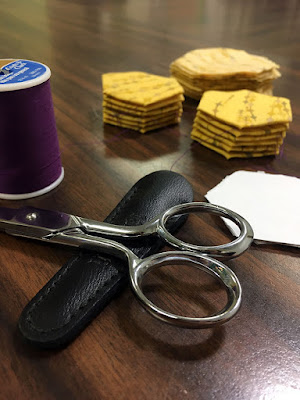I've passed the thousandth hexagon in my honeycomb quilt project (
I know, it's wild), and right about then, my little paper punch started tearing more often than slicing at one edge of the hexagons. Not a terribly useful trait in a tool I'm using for extremely precise quilting.
 |
| Featuring Dad's hands. You can't hear all the ragging happening around the table, though. |
So I brought it home to Dad. In the midst of a lot of friendly teasing about repair shop charges, reasonable assumption of risk in case of breaking the device, and warnings that even if he did get it apart, we might not be able to sharpen the cutting edge very well...he got the plate that protects the handle spring off. We all squinted at it for a while, and then put it back to try attacking the other side of the punch, where we could just see some promising-looking screws hidden under the edge of the plastic plate.
 |
| See? My tool-misuse is genetic. |
A few alarming creaking noises later (and with blatant abuse of a drywall scraper and a screwdriver), Dad got the top plastic plate free, and unscrewed the metal housing of the cutting blade. We each (just about—Grandma supervised) had a turn with Mum's little sharpener device (it's a little hunk of very hard steel-on-a-stick, and it works nicely), and then Dad put it all back together.
 |
| Back to hexagoning. |
And it works! Not perfectly—the cutting edge appears to be two-part, and slightly concave, so we could only really sharpen one edge—but cleanly enough that I can carry on with my project. And now I know how to tear the tool apart next time it needs to be sharpened.
 |
| There are (almost) no weeds in this photo. |
Meanwhile, out in the garden, the watermelons and cucumbers are getting ready to take off. I need to scrabble together some sort of trellis for the cukes soon, or they'll just be draped all over the ground. The melons can trail wherever they please; maybe I'll enlist them to help shade out some of the weeds.
 |
| We're high-tech gardeners. |
And the cotton looks good so far! I hope the soil drains well enough for it—I haven't grown much in the water of water-loving plants that can't stand wet feet, so this is all experimental. The soda bottles (or, to be really pedantic, tonic water bottles) have holes punched in their bases, so they can be filled with the hose and will release the water about a foot down in the ground. Ideally, they'll encourage the cotton roots to grow deep, which will protect them from temperature and moisture fluctuations at the surface.
 |
| There are still so many weeds, but at least none of them are close to reproduction yet. |
And I decided, while the soil was well-soaked and workable, to pull all the weeds rapidly approaching flowering age in the raised bed that's sort of disintegrated at one edge. And found beets! I'd planted beet seeds months ago, but nothing ever seemed to come of them, so I'd assumed they just weren't planning to show up at all—instead, we have about a dozen, which I separated from the clumps they'd germinated in and spread out to encourage better root formation. Hopefully they won't mind the relocation.
 |
| I'm charmed by the variegated thread in these eyelets. |
And I did indeed finish the eyelets on my sundress, and have put the lacing back in, so it's officially
done. I'm also very pleased with the decision to use the variegated thread; it stands out enough and matches enough to be extremely satisfying all around.
 |
| The afternoon light is just so pretty on this table. |
Lastly, I started the first gauge swatch I think I've ever worked, to get a baseline for the adjustments I know I'm going to need to make to the sweater pattern I've decided to knit next. It may not help me clear out the Basket of Shame, but it is helping me get a little more of the stash worked into something, and that seems well worth the effort. (Besides, if I start knitting now, I might have a light sweater ready by the time the weather requires one again.)








Comments
Post a Comment